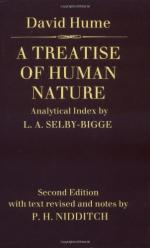|
This section contains 947 words (approx. 3 pages at 400 words per page) |

|
Book 3, Part 2, Of Justice and Injustice Summary and Analysis
Part 2 concerns the artificial virtues. He must consider whether moral distinctions are based on nature or nurture. Hume thinks that nature is responsible for some moral distinctions, nurture for others. Some virtues are part of human nature; these are the natural virtues. Justice and promise-keeping, however, are artificial. Natural virtues are built into human nature, always motivate types of behavior, produce good/pleasure whenever they operate and produce the sentiment of moral approval when observed in others.
In contrast, artificial virtues are not built into human nature; they have no always regulated human action. Instead, they come from self-interest where men are modified to have them through an evolutionary process that benefits them. The general practice of artificial virtue is beneficial to all and produces pleasure, but individual instances may cause...
(read more from the Book 3, Part 2, Of Justice and Injustice Summary)
|
This section contains 947 words (approx. 3 pages at 400 words per page) |

|




